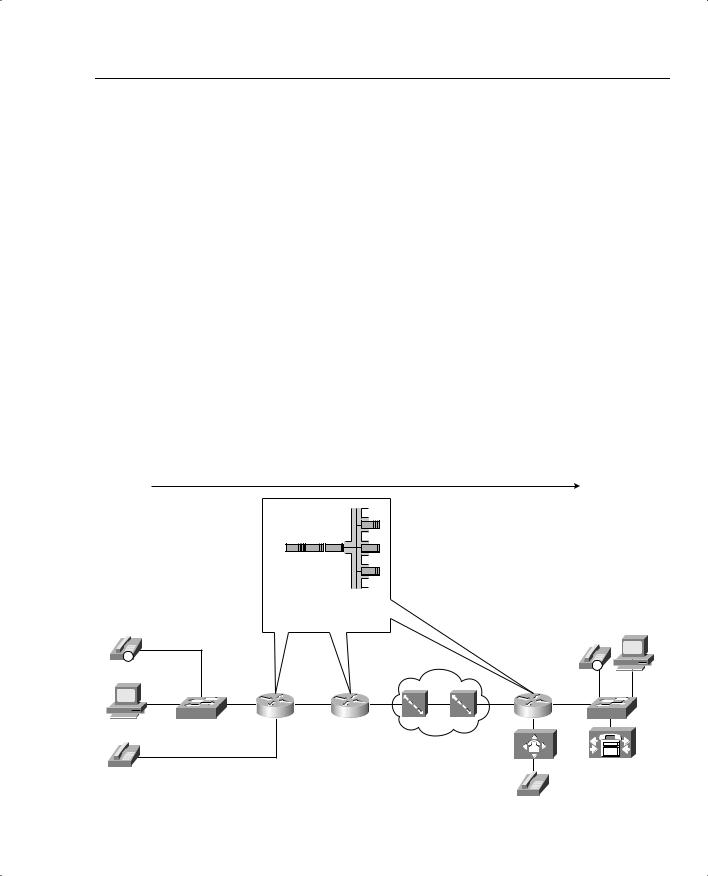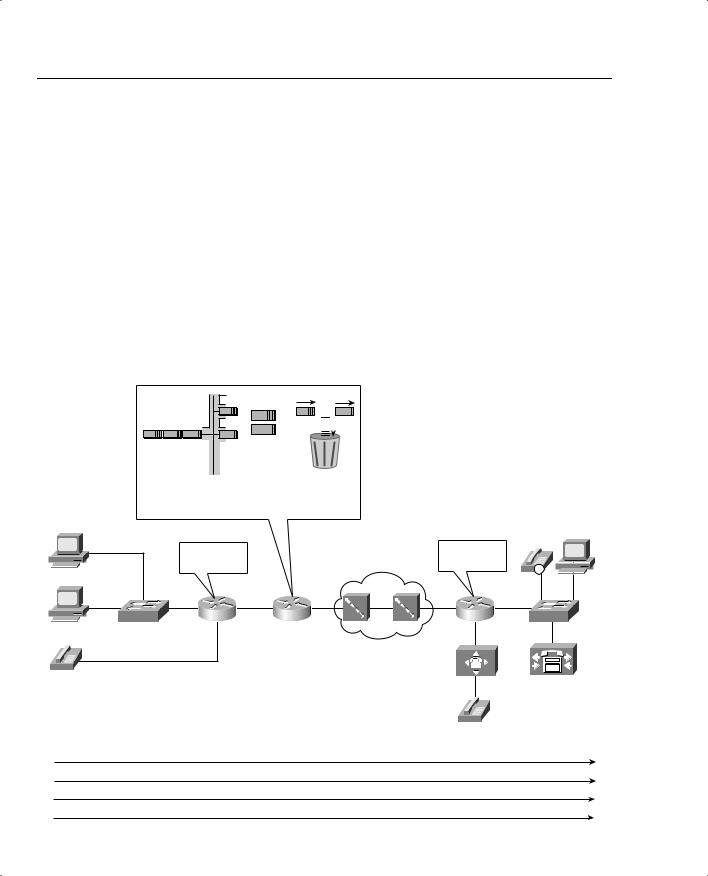
- •QoS Overview
- •“Do I Know This Already?” Quiz
- •QoS: Tuning Bandwidth, Delay, Jitter, and Loss Questions
- •Foundation Topics
- •QoS: Tuning Bandwidth, Delay, Jitter, and Loss
- •Bandwidth
- •The clock rate Command Versus the bandwidth Command
- •QoS Tools That Affect Bandwidth
- •Delay
- •Serialization Delay
- •Propagation Delay
- •Queuing Delay
- •Forwarding Delay
- •Shaping Delay
- •Network Delay
- •Delay Summary
- •QoS Tools That Affect Delay
- •Jitter
- •QoS Tools That Affect Jitter
- •Loss
- •QoS Tools That Affect Loss
- •Summary: QoS Characteristics: Bandwidth, Delay, Jitter, and Loss
- •Voice Basics
- •Voice Bandwidth Considerations
- •Voice Delay Considerations
- •Voice Jitter Considerations
- •Voice Loss Considerations
- •Video Basics
- •Video Bandwidth Considerations
- •Video Delay Considerations
- •Video Jitter Considerations
- •Video Loss Considerations
- •Comparing Voice and Video: Summary
- •IP Data Basics
- •Data Bandwidth Considerations
- •Data Delay Considerations
- •Data Jitter Considerations
- •Data Loss Considerations
- •Comparing Voice, Video, and Data: Summary
- •Foundation Summary
- •QoS Tools and Architectures
- •“Do I Know This Already?” Quiz
- •QoS Tools Questions
- •Differentiated Services Questions
- •Integrated Services Questions
- •Foundation Topics
- •Introduction to IOS QoS Tools
- •Queuing
- •Queuing Tools
- •Shaping and Policing
- •Shaping and Policing Tools
- •Congestion Avoidance
- •Congestion-Avoidance Tools
- •Call Admission Control and RSVP
- •CAC Tools
- •Management Tools
- •Summary
- •The Good-Old Common Sense QoS Model
- •GOCS Flow-Based QoS
- •GOCS Class-Based QoS
- •The Differentiated Services QoS Model
- •DiffServ Per-Hop Behaviors
- •The Class Selector PHB and DSCP Values
- •The Assured Forwarding PHB and DSCP Values
- •The Expedited Forwarding PHB and DSCP Values
- •The Integrated Services QoS Model
- •Foundation Summary
- •“Do I Know This Already?” Quiz Questions
- •CAR, PBR, and CB Marking Questions
- •Foundation Topics
- •Marking
- •IP Header QoS Fields: Precedence and DSCP
- •LAN Class of Service (CoS)
- •Other Marking Fields
- •Summary of Marking Fields
- •Class-Based Marking (CB Marking)
- •Network-Based Application Recognition (NBAR)
- •CB Marking show Commands
- •CB Marking Summary
- •Committed Access Rate (CAR)
- •CAR Marking Summary
- •Policy-Based Routing (PBR)
- •PBR Marking Summary
- •VoIP Dial Peer
- •VoIP Dial-Peer Summary
- •Foundation Summary
- •Congestion Management
- •“Do I Know This Already?” Quiz
- •Queuing Concepts Questions
- •WFQ and IP RTP Priority Questions
- •CBWFQ and LLQ Questions
- •Comparing Queuing Options Questions
- •Foundation Topics
- •Queuing Concepts
- •Output Queues, TX Rings, and TX Queues
- •Queuing on Interfaces Versus Subinterfaces and Virtual Circuits (VCs)
- •Summary of Queuing Concepts
- •Queuing Tools
- •FIFO Queuing
- •Priority Queuing
- •Custom Queuing
- •Weighted Fair Queuing (WFQ)
- •WFQ Scheduler: The Net Effect
- •WFQ Scheduling: The Process
- •WFQ Drop Policy, Number of Queues, and Queue Lengths
- •WFQ Summary
- •Class-Based WFQ (CBWFQ)
- •CBWFQ Summary
- •Low Latency Queuing (LLQ)
- •LLQ with More Than One Priority Queue
- •IP RTP Priority
- •Summary of Queuing Tool Features
- •Foundation Summary
- •Conceptual Questions
- •Priority Queuing and Custom Queuing
- •CBWFQ, LLQ, IP RTP Priority
- •Comparing Queuing Tool Options
- •“Do I Know This Already?” Quiz
- •Shaping and Policing Concepts Questions
- •Policing with CAR and CB Policer Questions
- •Shaping with FRTS, GTS, DTS, and CB Shaping
- •Foundation Topics
- •When and Where to Use Shaping and Policing
- •How Shaping Works
- •Where to Shape: Interfaces, Subinterfaces, and VCs
- •How Policing Works
- •CAR Internals
- •CB Policing Internals
- •Policing, but Not Discarding
- •Foundation Summary
- •Shaping and Policing Concepts
- •“Do I Know This Already?” Quiz
- •Congestion-Avoidance Concepts and RED Questions
- •WRED Questions
- •FRED Questions
- •Foundation Topics
- •TCP and UDP Reactions to Packet Loss
- •Tail Drop, Global Synchronization, and TCP Starvation
- •Random Early Detection (RED)
- •Weighted RED (WRED)
- •How WRED Weights Packets
- •WRED and Queuing
- •WRED Summary
- •Flow-Based WRED (FRED)
- •Foundation Summary
- •Congestion-Avoidance Concepts and Random Early Detection (RED)
- •Weighted RED (WRED)
- •Flow-Based WRED (FRED)
- •“Do I Know This Already?” Quiz
- •Compression Questions
- •Link Fragmentation and Interleave Questions
- •Foundation Topics
- •Payload and Header Compression
- •Payload Compression
- •Header Compression
- •Link Fragmentation and Interleaving
- •Multilink PPP LFI
- •Maximum Serialization Delay and Optimum Fragment Sizes
- •Frame Relay LFI Using FRF.12
- •Choosing Fragment Sizes for Frame Relay
- •Fragmentation with More Than One VC on a Single Access Link
- •FRF.11-C and FRF.12 Comparison
- •Foundation Summary
- •Compression Tools
- •LFI Tools
- •“Do I Know This Already?” Quiz
- •Foundation Topics
- •Call Admission Control Overview
- •Call Rerouting Alternatives
- •Bandwidth Engineering
- •CAC Mechanisms
- •CAC Mechanism Evaluation Criteria
- •Local Voice CAC
- •Physical DS0 Limitation
- •Max-Connections
- •Voice over Frame Relay—Voice Bandwidth
- •Trunk Conditioning
- •Local Voice Busyout
- •Measurement-Based Voice CAC
- •Service Assurance Agents
- •SAA Probes Versus Pings
- •SAA Service
- •Calculated Planning Impairment Factor
- •Advanced Voice Busyout
- •PSTN Fallback
- •SAA Probes Used for PSTN Fallback
- •IP Destination Caching
- •SAA Probe Format
- •PSTN Fallback Scalability
- •PSTN Fallback Summary
- •Resource-Based CAC
- •Resource Availability Indication
- •Gateway Calculation of Resources
- •RAI in Service Provider Networks
- •RAI in Enterprise Networks
- •RAI Operation
- •RAI Platform Support
- •Cisco CallManager Resource-Based CAC
- •Location-Based CAC Operation
- •Locations and Regions
- •Calculation of Resources
- •Automatic Alternate Routing
- •Location-Based CAC Summary
- •Gatekeeper Zone Bandwidth
- •Gatekeeper Zone Bandwidth Operation
- •Single-Zone Topology
- •Multizone Topology
- •Zone-per-Gateway Design
- •Gatekeeper in CallManager Networks
- •Zone Bandwidth Calculation
- •Gatekeeper Zone Bandwidth Summary
- •Integrated Services / Resource Reservation Protocol
- •RSVP Levels of Service
- •RSVP Operation
- •RSVP/H.323 Synchronization
- •Bandwidth per Codec
- •Subnet Bandwidth Management
- •Monitoring and Troubleshooting RSVP
- •RSVP CAC Summary
- •Foundation Summary
- •Call Admission Control Concepts
- •Local-Based CAC
- •Measurement-Based CAC
- •Resources-Based CAC
- •“Do I Know This Already?” Quiz
- •QoS Management Tools Questions
- •QoS Design Questions
- •Foundation Topics
- •QoS Management Tools
- •QoS Device Manager
- •QoS Policy Manager
- •Service Assurance Agent
- •Internetwork Performance Monitor
- •Service Management Solution
- •QoS Management Tool Summary
- •QoS Design for the Cisco QoS Exams
- •Four-Step QoS Design Process
- •Step 1: Determine Customer Priorities/QoS Policy
- •Step 2: Characterize the Network
- •Step 3: Implement the Policy
- •Step 4: Monitor the Network
- •QoS Design Guidelines for Voice and Video
- •Voice and Video: Bandwidth, Delay, Jitter, and Loss Requirements
- •Voice and Video QoS Design Recommendations
- •Foundation Summary
- •QoS Management
- •QoS Design
- •“Do I Know This Already?” Quiz
- •Foundation Topics
- •The Need for QoS on the LAN
- •Layer 2 Queues
- •Drop Thresholds
- •Trust Boundries
- •Cisco Catalyst Switch QoS Features
- •Catalyst 6500 QoS Features
- •Supervisor and Switching Engine
- •Policy Feature Card
- •Ethernet Interfaces
- •QoS Flow on the Catalyst 6500
- •Ingress Queue Scheduling
- •Layer 2 Switching Engine QoS Frame Flow
- •Layer 3 Switching Engine QoS Packet Flow
- •Egress Queue Scheduling
- •Catalyst 6500 QoS Summary
- •Cisco Catalyst 4500/4000 QoS Features
- •Supervisor Engine I and II
- •Supervisor Engine III and IV
- •Cisco Catalyst 3550 QoS Features
- •Cisco Catalyst 3524 QoS Features
- •CoS-to-Egress Queue Mapping for the Catalyst OS Switch
- •Layer-2-to-Layer 3 Mapping
- •Connecting a Catalyst OS Switch to WAN Segments
- •Displaying QoS Settings for the Catalyst OS Switch
- •Enabling QoS for the Catalyst IOS Switch
- •Enabling Priority Queuing for the Catalyst IOS Switch
- •CoS-to-Egress Queue Mapping for the Catalyst IOS Switch
- •Layer 2-to-Layer 3 Mapping
- •Connecting a Catalyst IOS Switch to Distribution Switches or WAN Segments
- •Displaying QoS Settings for the Catalyst IOS Switch
- •Foundation Summary
- •LAN QoS Concepts
- •Catalyst 6500 Series of Switches
- •Catalyst 4500/4000 Series of Switches
- •Catalyst 3550/3524 Series of Switches
- •QoS: Tuning Bandwidth, Delay, Jitter, and Loss
- •QoS Tools
- •Differentiated Services
- •Integrated Services
- •CAR, PBR, and CB Marking
- •Queuing Concepts
- •WFQ and IP RTP Priority
- •CBWFQ and LLQ
- •Comparing Queuing Options
- •Conceptual Questions
- •Priority Queuing and Custom Queuing
- •CBWFQ, LLQ, IP RTP Priority
- •Comparing Queuing Tool Options
- •Shaping and Policing Concepts
- •Policing with CAR and CB Policer
- •Shaping with FRTS, GTS, DTS, and CB Shaping
- •Shaping and Policing Concepts
- •Congestion-Avoidance Concepts and RED
- •WRED
- •FRED
- •Congestion-Avoidance Concepts and Random Early Detection (RED)
- •Weighted RED (WRED)
- •Flow-Based WRED (FRED)
- •Compression
- •Link Fragmentation and Interleave
- •Compression Tools
- •LFI Tools
- •Call Admission Control Concepts
- •Local-Based CAC
- •Measurement-Based CAC
- •Resources-Based CAC
- •QoS Management Tools
- •QoS Design
- •QoS Management
- •QoS Design
- •LAN QoS Concepts
- •Catalyst 6500 Series of Switches
- •Catalyst 4500/4000 Series of Switches
- •Catalyst 3550/3524 Series of Switches
- •Foundation Topics
- •QPPB Route Marking: Step 1
- •QPPB Per-Packet Marking: Step 2
- •QPPB: The Hidden Details
- •QPPB Summary
- •Flow-Based dWFQ
- •ToS-Based dWFQ
- •Distributed QoS Group–Based WFQ
- •Summary: dWFQ Options

104 Chapter 2: QoS Tools and Architectures
Figure 2-8 The Cisco QoS Framework
|
|
Mission Critical |
|
Multimedia |
|
VPNs |
VoIP |
|
|
Video Conference, |
|
||
|
Services |
|
|
|||
|
|
|
Collaborative Congesting |
|
|
|
|
|
|
|
|
|
|
|
|
|
|
|
|
|
-POLICY |
IntServ |
|
|
|
|
|
DiffServ |
|
|
|
|
MPLS |
|
|
Hybrid |
|||||||
|
|
|
|
|
|
|
|
|
|
|
|
|
|
|
|
|
|
|
|
|
||
|
|
|
|
|
|
|
|
|
|
|
|
|
|
|
|
|
|
|
|
|
||
|
|
|
|
|
Signaling Techniques (RSVP, DSCP*, ATM (UNI/NNI)) |
|
|
|||||||||||||||
BASED |
|
|
|
|
|
|
|
|||||||||||||||
|
|
|
|
|
|
|
|
|
|
|
|
|||||||||||
|
|
|
|
|
|
|
|
|
|
|
|
|
|
|
|
|
|
|
|
|
||
|
|
|
Classification & Marking Techniques (DSCP, IP Precedence, NBAR, etc.) |
|
|
|||||||||||||||||
NETWORKING |
|
|
|
|
|
|
|
|
|
|
|
|
|
|
|
|
|
|
|
|
|
|
|
|
|
|
|
|
|
|
|
|
|
|
|
|
|
|
|
|
|
|
|
||
|
|
|
|
|
|
|
|
Congestion Avoidance Techniques (WRED) |
|
|
|
|
|
|||||||||
|
|
|
|
|
|
|
|
|
|
|
|
|
|
|
|
|
|
|||||
|
|
|
|
|
|
|
|
|
|
|
|
|
|
|
|
|
|
|
|
|
|
|
|
|
|
|
|
|
|
|
|
|
Traffic Conditioners (Policing, Shaping) |
|
|
|
|
|
|||||||
|
|
|
|
|
|
|
|
|
|
|
|
|
|
|||||||||
|
|
|
|
|
|
|
|
|
|
|
|
|
|
|
|
|
|
|
|
|
|
|
|
|
|
|
|
Congestion Management Techniques (PQ, CQ, WFQ, CBWFQ, LLQ) |
|
|
|||||||||||||||
|
|
|
|
|
|
|
|
|
|
|
|
|
|
|
||||||||
|
|
|
|
|
|
|
|
|
|
|
|
|
|
|
|
|
|
|
|
|
|
|
|
|
|
|
|
|
Link Efficiency Mechanisms (Compression, Fragmentation) |
|
|
||||||||||||||
|
|
|
|
|
|
|
|
|
|
|
|
|
|
|
|
|
|
|
|
|
|
|
|
|
|
|
|
|
|
|
|
|
|
|
|
|
|
|
|
|
|
|
|
|
|
|
|
Frame |
|
|
PPP |
|
|
|
|
SDLC |
|
ATM, POS |
|
FE, Gig_E |
|
|
Wireless |
|
Broadband |
|||
|
|
Relay |
|
|
HDLC |
|
|
|
|
|
10Ge |
|
Fixed, Mobile |
|
Cable, xDSL |
|||||||
|
|
|
|
|
|
|
|
|
|
|
|
|
|
|
||||||||
MONITORING & PROVISIONING
The Good-Old Common Sense QoS Model
Most people already have some idea of what would be useful, and not so useful, regarding implementing QoS in a network. If you have been reading this book from the beginning of Chapter 1, you already know about the how QoS tools affect bandwidth, delay, jitter, and loss. You also know some of the traffic characteristics of voice, video, and data flows. You have seen the basics of how each general category of QoS tool works (Chapter 1), and you have at least seen a list of QoS tools in IOS (within this chapter).
With that in mind, you can mostly ignore DiffServ and IntServ and succeed at deploying QoS. Of course, you need to know more about each specific QoS tool, and you need to know how to configure the tools. You need to follow some good QoS design principles as well. However, you do not have to understand a lot about the DiffServ and IntServ models of QoS to succeed with QoS deployments.
However, most readers will find information about DiffServ and IntServ important for at least two reasons. First, the information is on the Cisco QoS exams! The other reasons is that the two formal models for QoS, DiffServ and IntServ, formalize and describe good QoS design models. You can deploy QoS without considering the concepts behind DiffServ and IntServ, but you will be better prepared for deploying QoS if you take the time to understand each model.
For those who are relatively new to QoS, before covering the depth and details in the upcoming chapters, you should consider some basic terms, concepts, and strategies for applying QoS in a network. This book summarizes these common strategies into what I call the “Good-Old Commonsense” (GOCS) QoS model, which summarizes what most people think of as just plain common sense about how to apply QoS. If you understand the GOCS model, you will already

The Good-Old Common Sense QoS Model 105
understand more than half of the concepts behind DiffServ, without letting the vast amount of terminology get in the way.
GOCS Flow-Based QoS
A flow consists of all the packets about which the following are true:
•All packets use the same transport layer protocol (for instance, UDP or TCP).
•All packets have the same source IP address.
•All packets have the same source port number.
•All packets have the same destination IP address.
•All packets have the same destination port number.
The slightly different, but just as exact definition, is that a flow consists of the packets between two IP sockets. For instance, a web browser on a PC, connecting to a server, creates a flow. (Actually, in the case of HTTP, it may create multiple TCP connections, which would actually be multiple flows.) Regardless, consider Figure 2-9. In this network, one flow exists from Hannah to Server1’s web server.
Figure 2-9 GOCS Approach to QoS for a Single Flow
Single Flow: Hannah’s Browser to Server1 Web Server
-Classify into Flows
-Apply Other QoS Tools, per Flow
-Performed at Each Router
Server 1
IP |
|
|
|
|
|
|
|
|
|
|
|
|
|
|
|
|
|
|
IP |
Hannah |
|
|
|
|
|
|
|
|
|
|
|
|
|
|
|
|
|
|
FA0 |
SW1 |
R1 |
s0 |
s0 |
R2 |
s1 |
T1 |
s0 |
R3 |
SW2 |
201 |
|
|
|
|
|
|
|
|
|
301

106 Chapter 2: QoS Tools and Architectures
The single flow shown in the figure consists of the packets sent by Hannah to Server1. Note that flows are unidirectional—in effect, two flows, one in each direction, would exist. To reduce the complexity, the samples in this section show flows going left to right only.
Flow-based QoS tools behave like the logic shown in the figure. Some QoS tools recognize flows and treat packets in one flow differently than another flow. So, common sense may imply that the QoS tools must first identify the packets that belong to this single flow, and then take some QoS action—such as queuing, LFI, shaping, and so on—for the packets in that flow. The tools may be applied for packets entering an interface, and other QoS tools may be applied for packets exiting an interface. Some tools may even be applied on the LAN switches. Some QoS tools may be applied in the Frame Relay cloud—but those are not typically under your control.
Real networks will have a widely varying number of flows, but the general ideas behind flowbased QoS tools do not change when more flows exist. Take a look at Figure 2-10, which shows a pretty small network with only four flows at this point.
Figure 2-10 GOCS Approach to QoS for Multiple Flows
? |
Dropped 


|
|
|
|
|
|
|
|
|
|
|
|
|
|
|
|
|
|
|
|
|
|
|
|
|
|
|
|
|
|
|
|
|
|
|
|
|
|
|
|
|
|
|
|
|
|
|
|
|
|
Class. (Flow-Based) Queueing |
Drop Policy |
||||||||
|
|
|
|
|
|
(Flow-Based) |
|
||
Vinnie |
Server 1 |
||||||||
|
|
|
|
|
|
|
|
|
|
|
Same General |
|
|
|
|
Same General |
|
||
|
Logic as R2 |
|
|
|
|
|
Logic as R2 |
IP |
|
|
|
|
|
|
|
|
|
|
|
Hannah |
|
|
|
|
|
|
|
|
|
|
|
|
|
|
|
|
|
FA0 |
|
SW1 |
R1 |
s0 |
s0 |
R2 |
s1 |
T1 |
s0 |
R3 |
SW2 |
201
301
Example with 4 Flows:
Flow1: Hannah’s Browser1 to Server1 Web Server
Flow2: Hannah’s FTP Client to Server1 FTP Server
Flow3: Vinnie’s Browser1 to Server1 Web Server
Flow4: Vinnie’s Browser2 to Server1 Web Server

The Good-Old Common Sense QoS Model 107
This figure shows four flows. Even though Vinnie sends all packets for both flows to Server1, they are in two different flows, because each of the two browser windows would open separate TCP connections, with different source TCP port numbers. (Note: HTTP 1.1 could cause multiple connections to be opened; FTP uses a control and data connection, which would result in two flows.) However, assume that only four flows exist at this point.
How does the GOCS model with flow-based tools change with multiple flows? Well, not much. Each flow must be identified, based on its unique source/destination address/port values. The QoS actions at each router may be different for each flow—for instance, maybe FTP just gets leftover bandwidth, or maybe Hannah gets better treatment for her web flow than does Vinnie. The reasons and rationale behind deciding what traffic gets what QoS treatment will change from network to network, but the basic process works the same:
•
•
•
•
Identify each packet, determining which flow it belongs to.
Apply some QoS action to the packets in each flow.
The QoS actions on a single router may be different for each flow.
The QoS actions among all routers may be different for each flow.
Flow-based QoS tools provide some advantages and some disadvantages. Because each separate flow is identified, the QoS tools can literally provide different levels of service to every flow. A single queue could be used for each flow, for instance, giving each a different reserved bandwidth. With a large number of flows, however, the overhead associated with keeping state information about each flow can be a lot of work. Imagine a router with 1000, or even 10,000, concurrent flows, which would not be surprising in the Internet—and then imagine the overhead in trying to perform queuing with 1000 or 10,000 queues! So, flow-based QoS tools provide a great deal of granularity, but they do not scale as well as some other QoS tools that do not consider flows (particularly with very large networks or the Internet).
Engineers gain another advantage and disadvantage when configuring flow-based QoS tools. Suppose that your job is to explicitly configure the routers in Figure 2-10 as to which source and destination IP addresses and ports to use to find each flow. And instead of 4 flows, there are 1000 concurrent flows. Over the course of a day, there may be hundreds of thousands of flows. Your job is to find the details that make each flow unique and configure it! Well, that would be rather ridiculous, a lot of work, and mostly impractical. Therefore, flow-based tools typically require no configuration to match and classify packets into a flow. However, some configuration control is lost.
The following list summarizes the key points about flow-based QoS tools:
•Flow-based QoS tools automatically recognize flows based on the source and destination IP address and port numbers, and the transport layer protocol.
•Flow-based tools automatically identify flows, because it would be impractical to configure parameters statically to match the large number of dynamically created flows in a network.
